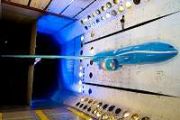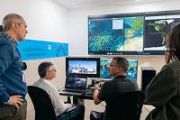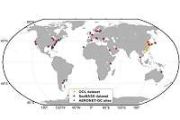
Copernical Team
NASA's EMIT will map tiny dust particles to study big climate impacts
 Blown by wind across continents and oceans, dust does more than make skies hazy, congest lungs, and leave a film on windshields. Also known as mineral dust or desert dust, it can influence weather, hasten snowmelt, and fertilize plants on land and in the ocean. Particles from North Africa can travel thousands of miles around the globe, sparking phytoplankton blooms, seeding Amazonian rainforests
Blown by wind across continents and oceans, dust does more than make skies hazy, congest lungs, and leave a film on windshields. Also known as mineral dust or desert dust, it can influence weather, hasten snowmelt, and fertilize plants on land and in the ocean. Particles from North Africa can travel thousands of miles around the globe, sparking phytoplankton blooms, seeding Amazonian rainforests Kacific launches all-in-one CommsBox for disaster relief
 Kacific Broadband Satellites Group is launching an innovative emergency connectivity solution, CommsBox, designed to provide broadband service in emergency or disaster zones rapidly.
Kacific CommsBox is a transportable, all-in-one satellite communications product that can be rapidly deployed in disaster zones when other communication channels fail. The turnkey solution is designed to meet
Kacific Broadband Satellites Group is launching an innovative emergency connectivity solution, CommsBox, designed to provide broadband service in emergency or disaster zones rapidly.
Kacific CommsBox is a transportable, all-in-one satellite communications product that can be rapidly deployed in disaster zones when other communication channels fail. The turnkey solution is designed to meet All the science in half the time: Sols 3464-3465
 We have cleared the "Greenheugh pediment" and the mix of sandy, steep, and rough terrain that challenged our drives up and down it. However, we are finding that as we make our way up Mount Sharp along a new route, some of the same driving gremlins are with us.
Yesterday's drive made it just about all the way to its endpoint, but Curiosity encountered higher than expected tilts as she attem
We have cleared the "Greenheugh pediment" and the mix of sandy, steep, and rough terrain that challenged our drives up and down it. However, we are finding that as we make our way up Mount Sharp along a new route, some of the same driving gremlins are with us.
Yesterday's drive made it just about all the way to its endpoint, but Curiosity encountered higher than expected tilts as she attem After ISS command change, NASA's Crew-3 prepares to undock for trip home
 NASA's Crew-3 astronauts are preparing to undock from the International Space Station on Thursday after a six-month stay at the orbital outpost.
Raja Chari, Kayla Barron and Tom Marshburn of NASA, along with Matthias Maurer of Germany, are expected to board their Dragon spacecraft and close the hatch at 11:20 p.m. EDT, ahead of undocking from the ISS for the trip back to Earth.
C
NASA's Crew-3 astronauts are preparing to undock from the International Space Station on Thursday after a six-month stay at the orbital outpost.
Raja Chari, Kayla Barron and Tom Marshburn of NASA, along with Matthias Maurer of Germany, are expected to board their Dragon spacecraft and close the hatch at 11:20 p.m. EDT, ahead of undocking from the ISS for the trip back to Earth.
C DARPA seeks proposals leading to in-space demonstration of nuclear thermal rocket
 DARPA is seeking proposals for Phases 2 and 3 of the Demonstration Rocket for Agile Cislunar Operations (DRACO) program for the design, development, fabrication, and assembly of a nuclear thermal rocket engine. The goal is to execute an in-space flight demonstration of nuclear thermal propulsion in fiscal year 2026.
The overall objective of DRACO is to enable time-critical missions over va
DARPA is seeking proposals for Phases 2 and 3 of the Demonstration Rocket for Agile Cislunar Operations (DRACO) program for the design, development, fabrication, and assembly of a nuclear thermal rocket engine. The goal is to execute an in-space flight demonstration of nuclear thermal propulsion in fiscal year 2026.
The overall objective of DRACO is to enable time-critical missions over va To sample or not to sample
 One of the prime objectives of the Perseverance mission is to collect a diverse cache of rock samples for eventual return to Earth. Among the highest priority rocks to sample are those that make up the well-preserved delta located on the western side of Jezero crater.
This delta was one of the key attributes that made this landing site so appealing for the search for ancient Martian life.
One of the prime objectives of the Perseverance mission is to collect a diverse cache of rock samples for eventual return to Earth. Among the highest priority rocks to sample are those that make up the well-preserved delta located on the western side of Jezero crater.
This delta was one of the key attributes that made this landing site so appealing for the search for ancient Martian life. Maritime Launch plans inaugural flight for 2023
 Maritime Launch Services Inc. (NEO: MAXQ) (MLSI) and Reaction Dynamics (RDX) are pleased to announce that they have signed a letter of intent to conduct launches from Spaceport Nova Scotia, expected to begin in 2023. These launches will provide the country sovereign launch capabilities and add Canada to the short list of "Launching States."
This partnership will advance the continuing plan
Maritime Launch Services Inc. (NEO: MAXQ) (MLSI) and Reaction Dynamics (RDX) are pleased to announce that they have signed a letter of intent to conduct launches from Spaceport Nova Scotia, expected to begin in 2023. These launches will provide the country sovereign launch capabilities and add Canada to the short list of "Launching States."
This partnership will advance the continuing plan NIC4 awarded satcomm service provider registry prototype contract for US Space Force
 NIC4, a subsidiary of Network Innovations, has been awarded a Service Provider Registry (SPR) prototype, a component of the Satellite Communications (SATCOM) Enterprise Management and Control (EM&C).
This software development effort is for the U.S. Space Force (USSF), Space Systems Command (SSC) through the Space Enterprise Consortium (SpEC) as an Other Transactional Authority (OTA) Agreem
NIC4, a subsidiary of Network Innovations, has been awarded a Service Provider Registry (SPR) prototype, a component of the Satellite Communications (SATCOM) Enterprise Management and Control (EM&C).
This software development effort is for the U.S. Space Force (USSF), Space Systems Command (SSC) through the Space Enterprise Consortium (SpEC) as an Other Transactional Authority (OTA) Agreem Satellogic announces multiple launch agreement with SpaceX
 Satellogic Inc. (NASDAQ: SATL), a leader in sub-meter resolution Earth Observation ("EO") data collection, reports it has signed a new Multiple Launch Agreement ("MLA") with SpaceX reserving launch capacity for its next 68 satellites. This new MLA follows the current MLA covering 2022 launches, and confirms that SpaceX continues to be Satellogic's preferred vendor for rideshare missions, meeting
Satellogic Inc. (NASDAQ: SATL), a leader in sub-meter resolution Earth Observation ("EO") data collection, reports it has signed a new Multiple Launch Agreement ("MLA") with SpaceX reserving launch capacity for its next 68 satellites. This new MLA follows the current MLA covering 2022 launches, and confirms that SpaceX continues to be Satellogic's preferred vendor for rideshare missions, meeting MDA completes first commercial sale of Canadarm3 technology to Axiom space
 MDA Ltd. (TSX:MDA), a leading provider of advanced technology and services to the rapidly expanding global space industry, has announced the first commercial sale of its Canadarm3 technology to Axiom Space.
The contract is for the delivery of 32 external robotic interfaces for Axiom Space's Axiom Station which is now under construction and on schedule to be the world's first commercial spa
MDA Ltd. (TSX:MDA), a leading provider of advanced technology and services to the rapidly expanding global space industry, has announced the first commercial sale of its Canadarm3 technology to Axiom Space.
The contract is for the delivery of 32 external robotic interfaces for Axiom Space's Axiom Station which is now under construction and on schedule to be the world's first commercial spa 



































